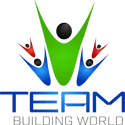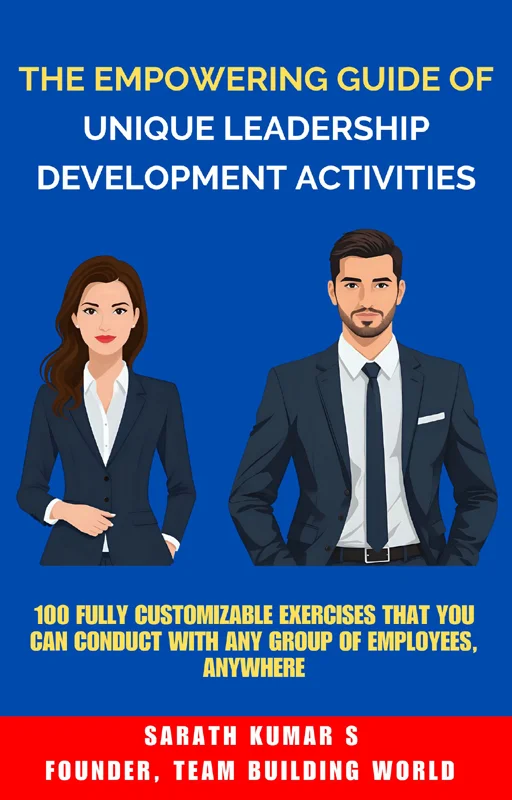10 Business Team Building Activities (With Debrief)
Are you looking for some business team building activities?
As a business leader, it is important to foster a strong and cohesive team to achieve success. However, building a cohesive team can be challenging, especially in a work environment where everyone has different personalities and priorities. That’s why incorporating experiential learning activities into your business strategy is crucial.
In this article, let’s explore 10 team building exercises for your business. These activities help your employees develop the necessary skills to excel in their jobs.
10 Business Team Building Activities
Here are some business team building exercises you can try with your employees.
#1. A 90 Second Pitch
This fast-paced activity challenges participants to think on their feet and present ideas or products in a convincing manner. It is an excellent way to practice public speaking, critical thinking, and persuasion skills.
Time: 10-15 minutes
Materials: None
Participants: Small teams of 2-6 people
Instructions
- Provide each team with a topic (e.g., new product idea, marketing strategy, etc.) and give them 5 minutes to come up with a pitch for it. Alternatively, you can have each team pitch the same topic.
- Once time is up, have each team present their pitch in just 90 seconds. Encourage them to be creative and persuasive in their delivery.
- After each team has presented, award points for the most convincing and well-delivered pitch.
Debrief
Discuss how the time limit challenged the participants to think quickly and present their ideas effectively. Highlight the importance of being able to concisely communicate ideas in a professional setting, such as sales pitches or project proposals.
You can also read: 10 Business Planning Games for the Workplace
#2. Business Mapping
Business mapping is a creative brainstorming technique that encourages participants to think outside the box and generate new ideas. It can be used for problem-solving, innovation, or team building purposes.
Time: 15-20 minutes
Materials: Whiteboards or large sheets of paper, markers, and sticky notes
Participants: Groups of 3-6 people
Instructions
- Divide the participants into teams. Next, provide each team with a whiteboard or large sheet of paper, markers, and sticky notes.
- Ask them to choose a topic related to their work (e.g., product development, marketing strategy, etc.) and create a mind map to explore different ideas and connections around the topic.
- Allow time for them to discuss and build on each other’s ideas while creating their mind maps.
- Once completed, have each team present its mind map and explain its thought process.
Debrief
Identify how the activity encouraged the participants to think creatively and work together to generate new ideas. Highlight the importance of open-mindedness, active listening, and collaboration in problem-solving as well as innovation efforts within a team.
You can also read: 12 Emerging Business Strategies for Leaders
#3. Negotiation Simulation
Negotiation skills are essential in business settings, and this simulation activity allows participants to practice these skills in a fun way. It also promotes critical thinking, communication, and teamwork.
Time: You decide
Materials: Written negotiation scenarios (e.g., salary negotiation, vendor contract, etc.)
Participants: Groups of 3-6 individuals
Instructions
- Provide each group with a written negotiation scenario that outlines the goals and objectives of both parties involved. Allow time for them to review the scenario together.
- Have each group designate one person as their spokesperson who will negotiate with the other teams. Give each spokesperson a set amount of time to reach a mutually beneficial agreement.
- Once all negotiations are complete, debrief and discuss the outcomes of each negotiation.
Debrief
Reflect on the importance of effective communication, compromise, and problem-solving in negotiations. Highlight any successful strategies or techniques used during the activity that can be applied in real-life scenarios.
#4. Vision Board Creation
This activity encourages participants to think about their goals and aspirations while also promoting creativity and collaboration. It’s a great way to kick off a new project or initiative and get everyone on the same page.
Time: You decide
Materials: Magazines, newspapers, poster board, and art supplies like markers, glue, etc.
Participants: 3-8 people in a group
Instructions
- Provide each team with the materials. Assign a theme for the vision boards (e.g., company goals, personal growth, etc.).
- Allow time for the teams to brainstorm ideas and create their vision boards. Encourage them to use a combination of images, text, and illustrations to express their ideas.
- Once completed, have each team present their vision board to the other groups.
Debrief
Discuss how creating a vision board helps individuals as well as teams clarify their goals and align with the company objectives. Highlight how creativity, collaboration, and communication were utilized during the activity and reflect on ways to incorporate these skills in work projects or tasks.
#5. Customer Service Scenarios
Customer service scenarios are an excellent way to practice communication, conflict resolution, and problem-solving skills in a safe environment. This activity is particularly beneficial for roles that involve direct interactions with customers.
Time: 15-20 minutes
Materials: A list of common customer service situations or role-playing scenarios
Participants: Pairs or small groups of 3-6 people
Instructions
- Provide the pairs or small groups with a list of customer service scenarios to act out. Alternatively, you can have the participants come up with their own scenarios.
- Allow each group time to discuss and prepare for their role-play. Encourage them to consider ways to resolve the issue while providing excellent customer service.
- Have each group perform their scenario in front of the other groups.
Debrief
Discuss how each group handled their scenario and ask for feedback from the rest of the participants. Highlight the importance of effective communication, problem-solving, and empathy in customer service situations.
#6. Role Reversal
This exercise allows group members to gain new perspectives by stepping into each other’s roles for a short period. It fosters empathy and appreciation for colleagues’ responsibilities.
Time: You decide
Materials: None
Participants: Pairs or small groups of 3-6 members
Instructions
- Pair up the participants or form small groups.
- Ask each participant to explain their job role, including responsibilities and challenges.
- Have the participants swap roles temporarily and attempt to perform each other’s tasks (in a simplified or hypothetical manner).
- After role-playing, gather the groups to discuss their experiences.
Debrief
Encourage the participants to share newfound insights about their colleagues’ roles. Discuss how understanding each other’s challenges can lead to better empathy, collaboration, and appreciation within the team.
#7. Balloon Tower Challenge
This is a lighthearted activity that encourages teamwork, problem-solving, and creativity while working under pressure. It also helps employees plan better and overcome challenges.
Time: 10-20 minutes
Materials: Balloons and tape
Participants: 3-8 individuals in a team
Instructions
- Divide the participants into teams and provide each team with a supply of balloons and a roll of tape.
- Explain the challenge: Teams must build the tallest freestanding tower possible using only balloons and tape.
- Set a time limit for the activity. For instance, 5-10 minutes.
- Once the time is up, measure each balloon tower and determine the winning team.
Debrief
Discuss what strategies worked best and explore how the teams overcame challenges during the activity. Highlight the importance of planning, clear communication, and adaptability under time constraints. Reflect on how these skills are relevant to work tasks or projects requiring collaboration and innovation.
#8. Mock Trade Show
This is a dynamic activity that promotes creativity, teamwork, and marketing skills. It allows participants to demonstrate their understanding of the company’s products or services while working together to attract potential customers.
Time: You decide
Materials: Company products or services information, promotional materials (e.g., brochures, flyers, etc.), and decoration items
Participants: Groups of 3-8 people
Instructions
- Divide the participants into teams and assign each team a product or service to promote. Next, provide them with relevant information and promotional materials.
- Allow time for the teams to brainstorm ideas and create their trade show booths using the provided decoration items.
- Once booth set-up is complete, teams take turns presenting and promoting their products or services to the other groups.
Debrief
Identify how each team approached the trade show challenge. Highlight how creativity, collaboration, and marketing skills were utilized during the activity. Reflect on how these skills can be applied in a real-life work scenario to promote company offerings and attract potential customers.
#9. Pictionary
Pictionary is a fun and creative game that boosts team spirit. It also encourages quick thinking and communication.
Time: 10-20 minutes
Materials: Whiteboard, markers, and a list of words or phrases to draw
Participants: Small teams of 3-6 people
Instructions
- Divide the participants into teams.
- Provide a list of words or phrases for one person from each team to draw while their teammates guess.
- Each team takes turns, with a time limit (e.g., 30 seconds) to guess the word or phrase based on the drawing.
- Award points for every correct guess. The team with the highest points wins.
Debrief
Discuss how creativity, quick thinking, and clear communication were crucial during the activity. Reflect on how these skills translate to real-world tasks that require effective teamwork and problem-solving. Highlight the importance of having fun and building camaraderie in the workplace.
#10. Company Trivia
This is an engaging activity that allows employees to test their knowledge about the company’s history, culture, and products or services. It promotes teamwork, creativity, and healthy competition.
Time: 10-20 minutes
Materials: List of trivia questions about the company (can be created by a designated employee)
Participants: 3-8 individuals per group
Instructions
- Divide the participants into groups.
- Provide each group with a copy of the trivia questions.
- Set a time limit for answering all questions (e.g., 10 minutes).
- Once the time is up, gather the groups to discuss the answers and determine the winner.
Debrief
Discuss how well the teams worked together to answer the questions and highlight any interesting facts or stories that emerged during the game. Reflect on how having a strong knowledge about the company can benefit the employees in their roles.
Want Some Unique Leadership Development Activities?
If you want some unique activities (both in-person and virtual) to equip your employees with leadership skills, qualities, and mindset, you can get my new e-book:
Or Want Some Unique Team Building Activities?
If you want some unique activities for your employees (both in-person and virtual), you can get my new e-book:
Final Words
Implementing these activities with proper debriefing sessions can lead to enhanced collaboration, communication, and a stronger sense of unity among coworkers. Remember, the key is to tailor these activities to your team’s specific needs and goals. This will ensure that your team building efforts are effective and impactful, leading to a more productive workforce. So, start conducting some activities today!
FAQ: Business Team Building Activities
You might have these questions in mind.
How do business team building activities improve workplace dynamics?
These activities promote better communication and encourage open dialogue among coworkers. By breaking down barriers, they foster a more collaborative and cohesive work environment.
What types of activities work best for remote teams?
Remote teams benefit greatly from virtual activities that encourage connection and collaboration despite being physically apart. Examples include online trivia games, virtual escape rooms, or collaborative problem-solving challenges conducted through video conferencing tools. These activities help build relationships, improve communication, and strengthen team dynamics in a remote setting.
How often should these activities be conducted?
The frequency of these activities depends on the needs and goals of your team. For most workplaces, organizing team building sessions every two weeks or at the start of major projects can help maintain a positive culture. Regular, smaller activities like icebreakers can also promote ongoing connection and engagement.

